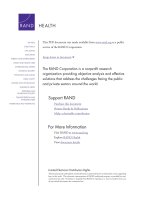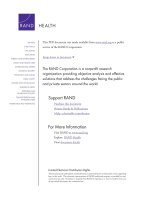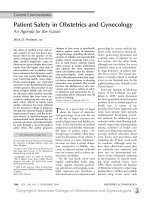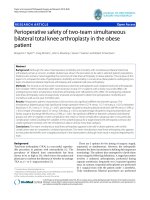Fracica patient safety checklists
Bạn đang xem bản rút gọn của tài liệu. Xem và tải ngay bản đầy đủ của tài liệu tại đây (5.17 MB, 8 trang )
Quality
Patient Safety Checklist: Keys to Successful
Implementation
By Philip Fracica, MD, Mohamed Lafeer, MD, FAAP, CPE,
Marie Minnich, MD, MMM, MBA, CPE, and
Raymond Fabius, MD, CPE, FACPE
No doubt exists regarding the importance of
developing patient safety programs in all clinical
care settings. The size, complexity, and multiple
interactions among the components of health care
delivery systems cause implementation of these
programs to be a difficult and daunting task.
When thinking about a safety program, there are 11
key concepts to keep in mind:
• Key implementation components
• Communication
• Culture
• Key tips for medication safety
• Medication system steps
• Methods to create favorable conditions for change
• Key techniques to measure the medication process
• Medical errors and prevention
• Process
• Knowledge
• Electronic medical records
When implementing a patient safety program it is
helpful to remember that all of the rules around change
management must be deployed. These include dividing
the process into incremental steps, seeking buy-in from
the staff, marketing the improvements the change will
produce, speaking to existing best practices and touting
the competitive advantages in the marketplace.
Specific successful approaches to implementing a
patient safety program include:
• Demonstrating error reductions
• Forecasting risk reduction
46
JULY • AUGUST 2006
THE PHYSICIAN EXECUTIVE
IN THIS ARTICLE…
During the 2005 ACPE Fall Institute, a group of
physician executives gathered to discuss key lessons
learned while implementing patient safety programs
and agreed to record, summarize and expand on this
topic so that others could benefit from this meeting.
• Identifying quality improvement
• Calculating the resources required
• Generating a business case with an adequate ROI
Two components central to the implementation of
patient safety programs are communication and culture.
Key implementation techniques recommended by experienced change management leaders include:
Initial culture and communication assessment survey
It is important for each organization to complete a
self-assessment of its patient safety culture and communication strengths and weaknesses prior to implementation
of programmatic changes. This self-assessment serves as a
baseline measure and a mechanism to raise awareness.
Some organizations attempt to generalize data
obtained from others as a shortcut. As physicians we are
aware of the risks attendant with “treating the most likely
causes” rather than establishing an accurate diagnosis and
initiating effective therapy.
Most organizations discover that identification of
issues specific to their situation is well worth the effort of
administering a survey tool. The U.S. Dept. of Health and
Human Services Agency for Healthcare Research and
Quality (AHRQ) provides a standardized hospital survey
on patient safety culture on it’s website
( />Areas of query include: assessment of whether
reporting incidents/errors results in punitive actions or
positive changes, whether workload and staffing levels
are appropriately matched, perception of managerial
emphasis on safety or working faster, and assessment of
channels of communication.
Conduct periodic culture and communication
reassessment surveys
Effectively use RCA and FMEA processes
A root cause analysis (RCA) is performed following
the occurrence of a significant incident or near miss. The
RCA should be performed by a multidisciplinary team
with membership appropriate to the incident. This team
focuses on the various causes or potential causes of the
incident with emphasis on a systems approach rather
than people approach.
The failure mode and effects analysis (FMEA) utilizes
an analogous process by selecting a process that could
result in an incident, i.e., a proactive approach. These
processes help direct attention to the importance of
potential errors and prioritization of change efforts.
Develop robust feedback mechanisms
These measurements serve as information gathering
mechanisms, as well as reinforcement of necessary culture and communications techniques. It is important to
work early and often on building a culture focused on
patient safety, emphasizing everyone’s role in patient
safety efforts. These cultural changes should be supported by both top down and bottom up approaches.
Build buy-in
These efforts need to be inclusive of all health care
providers and support personnel. Early efforts should be
aimed at influencing opinion leaders to facilitate development of a patient safety culture. Using external drivers
such as the Institute for Healthcare Improvement, the
National Quality Forum, and the Joint Commission on
Accreditation of Healthcare Organizations, among others,
can help develop buy-in.
Develop robust reporting tools
Encourage reporting of near misses and use these as
learning tools to improve patient care processes. Whether
reporting tools are paper-based or Web-based, ease of
completion and clarity are important. In many cases, reliable and easy-to-use systems can be acquired “off the
shelf” rather than investing in self-developed tools.
Reports should be equally easy to produce so that
personnel close to the work unit can easily access the
data. The easier to use, the more likely the system is to
be successful.
Develop educational tools
These may include live training exercises, videotaped
or CD lectures, case discussions, etc.
This allows for continual culture development and
assessment. These mechanisms include alternatives ranging from written and graphic reports, newsletters, personal stories, frequent senior leader safety walk-arounds, and
other types of communication.
Foster the development of a system focused, non-punitive safety culture
In most cases health care professionals involved in
errors are sincerely making their best efforts to provide
excellent care. Rather than identifying the individual as
the fault, we should make a concerted effort to identify
in what ways the system allowed the error to occur.
To focus on people as the problem does a disservice
to dedicated staff who can be set up to fail by a poorly
designed system and to our patients who remain exposed
to an unsafe system that is never addressed when we
jump to blame staff for problems.
A non-punitive environment encourages staff to
report errors and near misses. The system focus allows
an organization to use the reports to redesign processes
for higher reliability. This is a marked contrast to a culture of blame and shame where staff live in fear of
punishment for mistakes that they must hide.
THE PHYSICIAN EXECUTIVE
JULY • AUGUST 2006 47
Reinforce safe behaviors, refuse to tolerate unsafe
behaviors
Reinforcing the importance of safety policies by recognizing people and teams that consistently demonstrate
safe care supports the transition to a safety culture.
Likewise, clear and consistent non-tolerance for behaviors
that breach patient safety policies is critical.
This non-tolerant approach can coexist with a nonpunitive safety environment. Some organizations have
implemented self-reporting “safe-harbor” polices that provide staff with protection from disciplinary action when
they self report an error.
Develop effective communication techniques
• Using decision support tools at the clinical unit level
to assist the physician in selecting the appropriate
drug and dosage.
Transcribing—Was the order correctly transmitted to the
pharmacy? Transcribing can be improved by:
• Avoiding the use of high-risk abbreviations. Institutions
can educate staff about unsafe abbreviations. Some facilities place stickers on the charts or post signs in physician work areas reminding staff of the unsafe abbreviations. One effective strategy is to place a laminated card
listing unsafe abbreviations as a chart divider at the front
of the physician order section of the chart.
• Establishing standards for order legibility. It is
appropriate for the pharmacy to refuse to dispense
medication for orders with significant unaddressed
safety concerns such as illegibility.
• Avoiding verbal orders whenever possible and use of
read-back verification processes if verbal orders cannot
be avoided.
• Using high resolution scanning technology to transmit
physician orders to the pharmacy.
Emphasis on the interactions between various members of the care team enhances patient safety efforts.
Once culture and the communication of the need for
change has been addressed, the next step is to look at
specific areas where safety programs can be deployed.
Medication safety
The medication system is one of the main areas of
focus for any comprehensive patient safety program.
Functional integration of the inpatient medication system
and the outpatient medication system is increasingly
being recognized as a critical requirement for effective
improvements in patient safety.
The less structurally integrated ambulatory and inpatient care processes are, the more important it is to take
steps to provide some measure of functional integration.
While ambulatory medication system safety is clearly
important, much of the existing literature on medication
system safety focuses on the inpatient process.
The medication system can be considered to consist
of several steps:
Ordering—Was the right drug and dose prescribed? This
process can be improved by:
• Obtaining a reliable drug therapy history that can be
reconciled with current medications
• Checking that there is not a conflict between
prescribed drugs and recorded allergies
48
JULY • AUGUST 2006 THE PHYSICIAN EXECUTIVE
• Installing computerized physician order entry. CPOE is
a very promising innovation that is capable of providing real-time decision support input to the physician
about drug selection and dosing, as the order is being
written. CPOE promises to eliminate problems of legibility and miscommunication. A major challenge of
CPOE system implementation is fine tuning the decision support component to provide useful physician
prompts and suggestions without becoming intrusive
and disrupting the workflow.
Dispensing—Did the pharmacy provide the right medication to the right clinical unit?
The reliability of the dispensing step can be
improved by the use of automated drug dispensing technology. This is an exciting development and is likely to
be much more successful than interventions that rely on
increased human vigilance such as double-checking medication carts.
Other useful safeguard strategies include routine
pharmacy review of certain drugs, access control with
special labeling and dispensing precautions, use of standardized protocols for ordering, dosing and administration which include standardized solution concentrations
and preprinted protocol order sheets.
For drugs with narrow therapeutic windows, standardized mandatory drug level (or therapeutic endpoint)
testing with pharmacy review of the results is an effective
safety measure.
Pharmacy professionals should be involved
in a review of discharge medications
Another focus should be on medication reconciliation. Transitions of care and patient hand-offs from one
care environment to another can be a source of preventable adverse medication events. Important medications
may be inadvertently discontinued, or patients may
receive dangerous duplicate doses of medications.
For inpatients, the medication reconciliation process
should include a process to obtain a “reasonable best
effort” documentation of outpatient drug therapy that is
provided to the physician and the pharmacy compares
with the patient’s admission orders. Potential discrepancies are identified and resolved by communication with
the physician.
Upon transfer from one level of care to another,
there should be a process to reduce the chances for drug
omissions or duplication. And finally, pharmacy professionals should be involved in a review of discharge medications, which includes pre-admission outpatient therapy
and inpatient medication.
Administration—Did the nursing staff correctly administer and document the medication?
This is typically one of the most problematic areas.
For all of the other steps, there are opportunities for
other professionals to provide a safety net for errors.
For example, the pharmacist can identify a dosing
error in a physician’s order or clarify an illegible order
and a nurse can identify that the wrong drug was dispensed, but there are limited safeguards for administration errors. Strategies that can help improve the reliability
of the administration step include:
• Better monitoring of the accuracy of the process
through correlation of automated dispensing unit activity logs with medication administration records and
intermittent direct observation of medication administration by trained observers.
• Involving patients and families in the process. Patients
should be told what medications they are being
administered and encouraged to ask questions if they
are being given an unfamiliar medication.
• Double-checking processes for the administration of
high-risk medications. This can be effective if used
very selectively but is a poor substitute for automated
methods.
• Using bedside scanning technology to allow real-time
verification of proper administration and automated
documentation. This technology is not widely available
but holds great promise to revolutionize the reliability
and safety of drug administration.
It will be hard to achieve meaningful change if the
medical staff is not convinced that change regarding
medication safety is necessary or desirable. Experienced
health care leaders believe that these are effective
methods to create favorable conditions for change:
• Use examples of system failures. Examples of situations in which the medication system failed should disturb all health care professionals and motivate them to
prevent future similar harm to patients. This can be
achieved by use of confidentiality protected real-life
examples. Video dramatization of how failures occur
can be particularly effective. The Partnership for
Patient Safety® (p4ps.org) produces the “First Do No
Harm” videos. The Institute for Health System
Improvement (IHI.org) provides a video of the production “Charlie Victor Romeo” which is a dramatization of a series of aircraft disasters. These dramatizations are effective because they engage the audience
in a story that shows exactly how systems fail.
• Use examples of poor medication order writing.
Examples of near misses can also be effective. Illegible
order writing by physicians can be a frequent contributing factor to medication error. While the use of
CPOE systems may resolve this problem, until such
systems are in use, presenting examples of illegible
orders can help raise staff awareness of this problem.
• Make the malpractice case. Malpractice premiums are
a ubiquitous concern for physicians. Input from malpractice insurance carriers that effective medication
system safety initiatives can help curb malpractice rates
and protect physicians can be a very effective message. Establishing system-focused programs to improve
systems and prevent future liability has been called
“proactive risk management.” Colorado Physicians
Insurance Company (COPIC) is a physician-sponsored
malpractice insurer that provides coverage for 75 percent of Colorado physicians. COPIC’s proactive risk
management approach includes near-miss reporting,
THE PHYSICIAN EXECUTIVE
JULY • AUGUST 2006 49
risk assessment surveys of practice patterns and a malpractice price structure tied to safety survey scores,
corrective action and participation in risk reduction
programs. While the COPIC initiative is the best example of a direct linkage between adoption of patient
safety practices and reductions of malpractice premiums, other malpractice insurance carriers such as
Medical Mutual have begun to emphasize proactive
risk management.
• Make the business case. Improved patient safety has
been shown to reduce health care costs by decreasing
costly adverse events. According to the American
Journal of Health-System Pharmacists, over 3 percent
of hospital admissions result from a need to treat a
medication error. Over 4 percent of hospitalizations
are complicated by an adverse drug event and the
average additional cost of an admission attributable to
an ADE is over $2,000. Educating staff about the financial benefits can be effective as long as it is made
clear that patient welfare, not finances, is the primary
driver of the change initiative.
• Educate staff about external drivers of change. It is
impossible to get full buy-in from everyone. There are
always some staff members who will argue and resist
any change. The need to comply with national standards, particularly those mandated by regulatory or
accrediting agencies such as CMS and JCAHO can be
cited as an effective reason for change for those staff
who don’t get it.
Medication process
It is difficult to change a process that cannot be
measured. Effective change requires effective measurement so that improvement goals can be set and progress
can be monitored. Patient safety advocates recommend
these techniques to measure the effectiveness of medication system safety initiatives:
Establish and measure indicators for medication
system safety.
Institutions can measure process indicators (such as
the percentage of illegible orders received or the number
of orders written which fail to adjust dosage for renal
function) and outcome indicators (such as the frequency
of adverse events such as hypoglycemia or anticoagulant
related hemorrhage). These indicators can help an institution prioritize areas that need improvement and are critical to assessing whether system changes are having the
desired beneficial effects.
50
JULY • AUGUST 2006 THE PHYSICIAN EXECUTIVE
Use external benchmarks.
While it is important for every institution to have its
own goals for improving patient safety, it can be instructive to compare performance with similar organizations.
This benchmarking can help identify areas that may need
particular attention for improvement.
Track and trend events.
When adverse events occur, it is important to try and
identify and trend common contributing factors such as lost
orders or poor legibility. This tracking can help the institution identify priorities for systematic improvement.
Institute near miss reporting.
Organizations with an effective safety culture will not
just focus on adverse events but will actively measure near
miss events. These are situations where some aspect of the
system failed, but a vigilant staff member intervened to prevent or significantly reduce the actual patient harm.
Institutions should view near miss reports as patient safety
“treasures” since they can teach us valuable lessons about
potential deficiencies in our systems, without having to pay
the price of an adverse patient outcome. Institutions with a
healthy patient safety culture do not ignore multiple near
miss events and wait for a serious adverse patient outcome
to take effective corrective action.
Assess risk.
While effective measurement of adverse events and
near misses are important, there are some medication
safety practices that should be instituted as a routine matter. These are issues that have been demonstrated to be
important safety concerns at other institutions. JCAHO
Sentinel Event Alerts and Institute for Safe Medication
Practices Quarterly Action Agendas (formerly Safety
Alerts) are notable examples.
While it is important to measure patient safety performance, measurement alone is not enough. The goal of
the measurement process is to provide the necessary
environment to support effective change. The use of an
effective strategy such as rapid cycle testing in a series of
PDSA (Plan Do Study Act) cycles is essential in order to
improve the safety and reliability of the medication system. It is critical to act upon the information provided by
measurement systems and then re-measure the process to
assure that the desired outcome has indeed been
achieved.
In addition to investigating root causes of adverse
events and learning from other institutions, organizations
can engage in proactive risk assessment activities such as
failure mode effect analyses.
FMEA involves mapping out a process from start to
finish into component steps. A team of staff members who
are familiar with the process will then consider how the
process might hypothetically fail, step-by-step. Each possible
failure is scored based on the anticipated frequency, severity
and likelihood of detection of the failure. This gives an
overall risk score for each step and for the entire process.
Steps with the highest risk scores generally contribute the
highest risk and should be redesigned.
These different risk assessment methods are complementary and will often identify the same high risk areas
of the medication system such as administration of
insulin, opiates and narcotics, benzodiazepines, anticoagulant therapy, injectable KCl, hypertonic saline and
cancer chemotherapy agents.
Medical error prevention
Another major area to focus on regarding patient
safety is medical errors because they result in highly significant morbidity, mortality and excess costs.
Medical errors can be classified into two categories:
paper record retrieval and review prior to providing care.
So how can an EMR help to address medical errors?
How is an EMR better than a paper system if they contain
the same materials? There are many facets of an EMR
that can prevent medical errors:
Health maintenance prompts and proactive care
An EMR will prompt a physician to order a health
maintenance test such as a mammogram. The EMR
prompt can prevent a patient safety issue from developing if the test is ordered. Most patient care is reactive and
episodic. When an EMR is used reactive visits can include
more proactive care and all visits can include optimization of disease management. An EMR can also use a disease registry for population management and this can be
integrated with a secure patient portal for eVisits.
Medication management
1. Process errors— those related to administrative tasks,
initial investigation, treatment delivery, communication
and payment
Using an EMR with a medication manager, a clinician
can reduce a variety of medication prescription errors.
These errors include mistakes related to illegible handwriting, selection of the wrong dose of medicine, and
prescribing two or more different medications that end
up causing an adverse drug interaction, etc.
2. Knowledge errors— those related to a lack of access
to clinical knowledge or skills
Complete patient history
Administrative errors and knowledge errors related to
information access and delivery are among the most preventable of all medical errors. What all of these errors
share is a direct relationship to health care documents,
including patient records, physician orders, prescriptions,
test results, insurance forms and many others.
Typically, administrative errors can be traced back to
an inaccurate source document as a result of poor document management.
Electronic medical records
In a properly executed EMR all information is available at the clinician’s finger tips without having to sort
through a voluminous paper chart that may be incomplete. Organization of the records is much easier in the
electronic format and data can be mined very efficiently
for the management of the patient.
Interoffice communication
With an EMR, clinicians can send intra-office messages to one another that are time-sensitive and high-priority which leads to timely care of the patient and reduction of medical errors.
Paper records are subject to errors from poor or misinterpreted handwriting. Many medical errors can be
attributed to the slow, tortuous and unreliable process of
Complete documentation
In an ideal EMR, all of the relevant clinical reports
including those from lab, imaging, physical therapy, etc.,
THE PHYSICIAN EXECUTIVE
JULY • AUGUST 2006 51
and those from consultants are loaded into a preformatted matrix and cross-linked for continuity of care. Even
patient inputs are included in some EMR systems. There
is less chance of an error when care is being provided by
many sources and all the information from those sources
is placed in a medical record.
Electronic decision support systems
Information systems that provide evidence-based
medical knowledge at the time of care can standardize
clinical decision-making and reduce the clinical decision
error rate. This enables practitioners to benefit from
expert advice at the point of care. Decision support system designers can never anticipate every possible set of
circumstances. Optimal decision support system design
and management allow the system to evolve and improve
through feedback from users.
Having information that is standardized, usable, and
shareable is the very essence of error reduction An EMR
allows a health system to easily audit the quality of care
and develop patient safety programs with the knowledge
that the audits obtain. A comprehensive information system
will provide an extension to the future National Quality
Forum’s patient safety event taxonomy, which is intended
to facilitate a common approach for patient safety.
While increasing sophistication is slowly reducing
medical errors, all efforts must start with awareness. As
staff members understand their own limitations and that
of the system, improvements can be made.
We hope that some of these key tips will prove helpful to your efforts to improve the safety and reliability of
existing systems while we work together to build the systems of the future. Preventing even one misadventure can
be a compelling justification for these efforts.
First, do no harm.
Brush Up On Ways to Creatively
Manage Your Organization
52
JULY • AUGUST 2006 THE PHYSICIAN EXECUTIVE
Philip Fracica, MD, is medical director of quality
improvement and critical care services at St.
Joseph’s Hospital and Medical Center in
Phoenix, Ariz. He can be reached at
Marie E. Minnich, MD, MMM, MBA, CPE, is
chairperson of the Performance Improvement
Advisory Group for the Division of
Anesthesiology of Geisinger Health System in Danville, Pa.
She may be reached at
Mohamed Lafeer, MD, FAAP, CPE, is the medical director of quality improvement and compliance for Shah Associates, MD, LLC, in
Hollywood, Md., and the medical director for health prime
international in Rockville, Md. He can be reached at
Raymond J. Fabius, MD, CPE, FACPE, is president and chief medical officer of I-trax
(AMEX:DMX) and a member of the ACPE Board
of Directors. He can be reached at
2006 FALL INSTITUTES
First, unleash the power of the creative process
and then use it to explore the potential of a new enterprise!
Fostering Creativity in
Medical Management
November 11 -12
Kevin O’Connor, MA
• Use creativity to infuse new life into
your staff and all your service lines
• Help your project teams side-step the
roadblocks they seem to hit over and
over again
• Develop strategies for team-based,
creative problem solving approaches
Business Innovation: 12
Steps to Prioritize New
Opportunities
A Medical Management
event for physician executives at EVERY stage of their
careers held at the Westin
La Paloma Resort and Spa
and Westward Look Resort
in scenic Tucson, Arizona.
November 13 - 14
Arlen Meyers, MD, MBA
Courtney Price, PhD
Register
800-562-8088
Visit ACPE.org/Fall
Call
Innovation is the pathway of taking ideas to
the marketplace and making them successful.
Successful innovation happens in three phases
– Identifying Opportunities, Selling Your Idea
and Executing a Delivery Plan.
Learn how to take your concept for a new
product or service of innovative process to the
next step!
THE PHYSICIAN EXECUTIVE
JULY • AUGUST 2006 53









